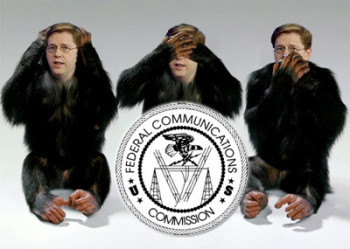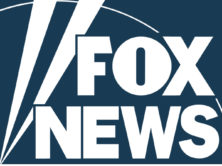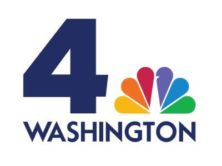
Correspondent Sabrina Ali picked up the phone and posed a simple question to the Federal Communications Commission: How does the FCC, an organization charged with overseeing the nation's airwaves, plan to monitor television coverage of the 2008 presidential election?
Getting a straight answer to that question, however, became a journey through a maze of red tape, off-the-record conversations and doublespeak. In the first of two reports, Ali ponders the fading ideal of the “public interest” and the diminishing accountability of our public institutions.
|
SPECIAL REPORT
|
||||||||||||
| STINKYJOURNALISM STUDY: Fred Finishes First Thompson Number 1 – among GOP amd Dems – in Newsweek Article Race |
||||||||||||
[RELATED]
|
How did researching Fred Thompson’s presidential run make me doubt the legitimacy of the FCC? In short: I couldn’t find anyone out there – outside or within the organization itself – to explain to me how it was doing any public good.
This story begins with a shorter article I was working on about Fred Thompson’s recent appearance in a radio commercial for the company LifeLock, and whether it would trigger the FCC’s equal airtime rule. Otherwise known as Section 315 of the Communications Act , the equal airtime rule stipulates that if a station offers one candidate airtime, it must offer equivalent airtime to all others, ostensibly to prevent media favoritism of one candidate and to promote the expression of multiple viewpoints. Even after reading 315 a few times, I still wasn’t sure which of Thompson’s numerous media roles would trigger it. In fact, the more I read about the rule, the less clear it became. I was willing to write it off as general government incompetence, but the lab staff encouraged me to call the FCC and hear what they had to say.
So I prepared a list of questions and started calling the various divisions within the FCC. I slogged through countless automated telephone systems and grimaced at the transfers and long minutes on hold. Finally, I made contact with a real-live FCC official from the Media Bureau. But my excitement was short-lived; he said that nobody in the building was allowed to comment for attribution, and that I was forbidden to record anything he said—all part of an agency-wide policy. I couldn’t quote him anonymously because, he insisted, his colleagues “would know it was him.”
I then sent an email with some questions to the agency’s Political Programming Unit. The subject line of the response read: “Your phone number, please!” They wanted to discuss the issue by phone. “Thank you! Your cooperation is appreciated!” All those friendly exclamation marks lulled me into a false sense of security. But the attorney who contacted me from that office told me that I couldn’t quote or paraphrase her—not even anonymously, because they’d know it was her. A pattern seemed to be emerging.
The anonymous official seemed surprised and amused when I questioned the policy of not being quoted on the record. Apparently, nobody else she’d talked to had expressed a problem with it at all. She did, however, offer to fax me court decisions for background information.
It took over a dozen phone calls to contact an official FCC spokeswoman. When I posed my questions to her about the implementation of 315, she snapped, “I would not be commenting on the record about these questions.” She then hurriedly shrugged me off and – on par for the course – pointed me to the FCC website. I responded that I’d been to the site and hadn’t found answers to my questions. To this final appeal, I received no response. I was disturbed by the contradiction: The FCC is supposed to work in the public interest, yet its own policies seemed to shut it off from public inquiry and scrutiny.
Why we have the FCC in the first place
In spite of my feelings, these policies were indisputably out of line with the FCC’s charter. The agency had been created in the 1930s in an attempt to make the government more responsive to the people’s needs. During the 1920s, the country’s business landscape was sliding toward monopoly dominated by wealthy industrialists. Lack of state oversight and laissez-faire economic policies allowed certain industries to consolidate tremendous power. When the Great Depression hit, people recognized Washington’s deregulatory agenda as a contributing factor to the financial catastrophe and demanded greater government oversight and regulation . In response, newly elected president Franklin Delano Roosevelt began the New Deal, his plan to lift America out of the Depression by expanding the federal government’s power and making it more responsive to the needs of ordinary citizens – not just corporations. At the heart of Roosevelt’s New Deal programs were a slew of federal regulatory agencies that broadened and centralized government authority. The FCC was one of them.
Created to execute the Communications Act of 1934, the FCC was given broad regulatory powers over the nation’s airwaves. According to The Communications Act, the FCC was responsible for overseeing communications technology. But it was also supposed to uphold a critical tradeoff: since media outlets are given access to a limited spectrum of airwaves they are expected to run a certain amount of programming in line with the “public interest.” The Act, however, left “public interest” noticeably vague, most likely to allow the concept to be applied to a variety of situations effectively. Even without a concrete definition of public interest, it was clear that the needs of the citizens had to be the media’s categorical top priority. Stations could have their licenses revoked if they did not uphold this standard. And, for a while, the agency carried out these duties effectively. In 1949, the Fairness Doctrine, an attempt to ensure that issues affecting the public received balanced media coverage, was introduced. In 1960, the FCC banned payola, the practice of paying DJs to disproportionately feature a certain artist’s songs. In the same era, the agency upheld relatively meaningful limits on the number of media outlets one company could own.
A closer look at the agency, however, reveals that it has only been effective in pro-regulatory administrations, such as Roosevelt’s. Since the Reagan administration, however, the state has largely reverted to the deregulatory, laissez-faire policies that characterized the period preceding the Great Depression. During the same period, the FCC has been largely stripped of its broad powers and obligation to regulate big business. Indeed, the role of the agency has shifted along with the government’s pro-consolidation ideology. Because Reagan appointed Chairmen that supported his economic program, the 1980s saw the FCC shift away from media regulation. Reagan-appointed Chairman Mark Fowler’s description of a television as “just another appliance…a toaster with pictures” characterized the agency’s attitude during the 1980s, and largely, the period that has followed.
This has resulted in a weakening – and in some cases a complete reversal – of many of the regulations it had once enforced. For example, the Fairness Doctrine was repealed in 1987 and record companies have found ways around the payola ban. Most notably in this era, ownership limits have been drastically loosened or removed altogether, thanks to the efforts of the 1980s’ FCC, and the Telecommunications Act of 1996, which lifted ownership limits for radio and television stations, extended broadcast license terms, and deregulated cable rates.
Looking to the past to understand the present
Knowing I wasn’t going to get much from current FCC members, I looked to the past. I called Reed Hundt, FCC Chairman during the Clinton administration, and asked what the FCC’s is supposed to do in terms of monitoring and regulating media coverage of elections. “It doesn’t do much of anything,” Hundt replied. “It’s not a policy goal of the current commission. I can’t remember anyone there ever speaking about it.” Intrigued by Hundt’s responses, I spent a few weeks researching the current FCC and its role in regulating media coverage of elections through the equal time rule.
I found that the FCC has been paralyzed by its unwillingness to make definitive policy decisions. History suggests that it only clarifies the law and its boundaries when confronted with specific cases, making it hard to tell when and how the law should be applied. It is therefore difficult to hold the FCC accountable for enforcing 315, because the agency has gone to so little trouble to clarify what types of violations actually merit enforcement.
When the agency does clarify 315, it usually does so by granting nonsensical exemptions to the rule, weakening its strength. The agency has outlined four categories of exemptions from 315: newscasts, news interviews, news documentaries, and on-the spot coverage of news events. While these categories may sound straightforward, over the years, they have been altered so that certain candidates have appeared on shows that are hardly bastions of “serious” news. Hosts that have received exemptions from the equal airtime rule include Sally Jessy Raphael, Oprah, and Jay Leno. Andrew Jay Schwartzman, President and CEO of the non-profit public interest group Media Access Project, laments in an interview: “The exemptions have been read in an overbroad way, and the law needs to be modified to make clear what a bona fide news interview program is.” Indeed, in 2003, the FCC deemed Howard Stern’s radio show a “bona fide news interview” program so that Stern could interview gubernatorial candidate Arnold Schwarzenegger without having to offer airtime to the other candidates. Who’s next in line for an exemption, Jerry Springer? Oh, wait—he already has one.
Broadcasters have already taken advantage of the agency’s impotence by finding ways to circumvent the law. In 2004, media conglomerate Pappas Telecasting Companies gave California Republicans access to seven TV networks and two radio stations during the last days of the campaign. To uphold 315, Pappas provided Democrats with access to a Spanish-language television station that only covered the San Francisco area. Pappas was clearly giving the Republicans favored coverage, grossly violating the spirit of the rule to play politics.
The FCC helps corporations avoid 315 by placing the burden of discovering and handling 315 violations almost entirely on the public and the candidates. For example, when a candidate appears in programming that would trigger the equal time rule, neither the broadcaster nor the FCC has any obligation to inform other candidates or advertise this information at all. The FCC even admits (albeit off-the-record and anonymously) that the broadcaster must simply place a note in the station’s political file, and it’s up to the other candidates to check this file to see if 315 has been triggered.
Even if the 315 has been triggered, the agency still does not necessarily get involved. Only after a candidate has checked the political file, found out that the rule was invoked, contacted the broadcaster, requested equal time, and been denied equal time can the candidate come to the FCC for enforcement—if the FCC even agrees that the rule has been activated, that is. And when the agency does get involved, its most common method of enforcement is “informal mediation”—the FCC makes a phone call to the broadcaster and discusses the problem; while punitive measures can include fines, they rarely extend beyond this phone call, according to an FCC source who wished to remain unnamed out of fear of reprimand.
Things get even murkier when we look at the way 315 is applied to cable networks. In 2000, cable network A&E requested that the FCC declare its documentary program, “Biography,” exempt from 315. In its typical piecemeal fashion, the agency granted A&E the exemption for that specific show, but it refused to make a generalization for all cable programs. Such ad hoc decision-making has mired the law in unnecessary uncertainty. For example, during the California recall, Arnold Schwarzenegger’s movies were cut from some networks, but remained on others. The inconsistent enforcement of 315 is a sign of not only a weak rule, but also a weak agency, one that has been either unable or unwilling to adequately regulate media coverage of elections.
The FCC’s ineffectiveness extends beyond the realm of election coverage. Since the 1980s, the agency has prioritized corporate interest over the public good. The FCC’s lax enforcement has allowed for the formation of powerful media conglomerates. These corporations and their lobbyists, in turn, push the FCC to further deregulate the media, which results in even more consolidation. Indeed, the FCC’s failure to enforce the equal time rule is the result of the agency’s corporate entanglements. I will explore this phenomenon in my next installment.
Sabrina Ali interned at ASRL for two months after graduating from New York City’s Hunter College High School in June. She will start at Yale University in September.







Comments Terms and Conditions